FEATURES|THEMES|People and Personalities
A Tribute to Kyabje Trulshik Rinpoche
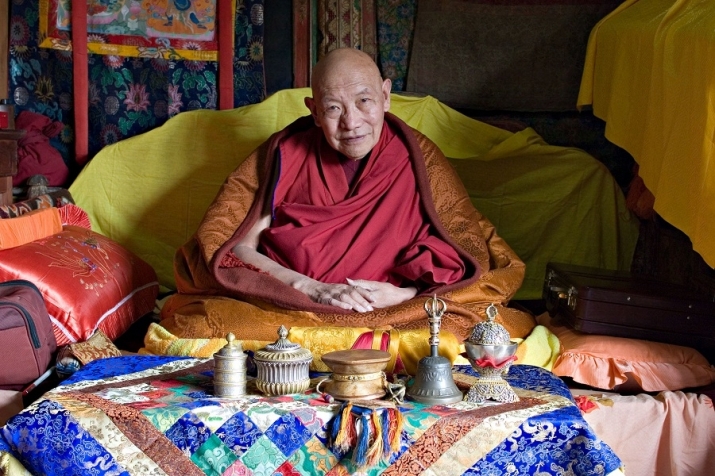 Trulshik Rinpoche at Thubten Chöling, 1990s. Photo by Thomas Kelly
Trulshik Rinpoche at Thubten Chöling, 1990s. Photo by Thomas KellyThis article is published to coincide with the birthday of Trulshik Rinpoche’s yangsi on 25 July.
Kyabje Trulshik Rinpoche, Ngawang Chökyi Lodro (1924–2011), was the incarnation of Zhadeu Trulshik Kunga Rinchen of Dzarong in Tibet. An emanation of the bodhisattvas Vajrapani and Manjushri, he was one incarnation in a succession of births manifested to benefit beings. They include, in India, the Buddha’s disciple Ananda; the master Aryadeva; and the abbot Shantarakshita; and in Tibet, Thönmi Sambhota, King Songtsen Gampo’s minister and the author of the first texts on Tibetan grammar; the great translator Vairotsana; Milarepa’s disciple Rechungpa; and the omniscient Longchenpa. More of Trulshik Rinpoche’s previous lives are mentioned in the prayer to his successive rebirths.
Trulshik Rinpoche’s father, Tenzin Chödar, was a descendant of the Indian Licchavi clan, and his mother, Jamyang Wangmo, was a descendant of Önrey Dharma Senge, the nephew of Tsangpa Gyare, who founded the Drukpa Kagyu lineage. Trulshik Rinpoche’s parents lived in Önrey’s house near Yamdrok Taklung in Tsang, Central Tibet, and he was born in Önrey’s meditation cave amid many miraculous signs on the tenth day of the ninth month of the Wood Mouse Year, or 6 November 1924.
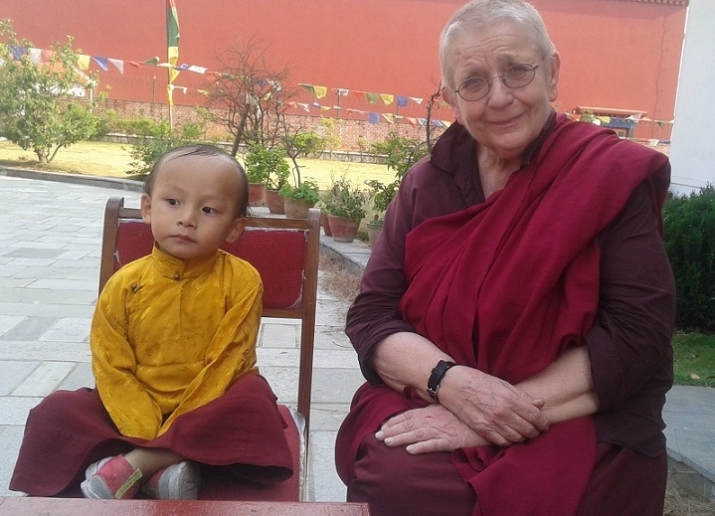 Trulshik Rinpoche's yangsi and Ani Jinba at Sitapaila, April 2016
Trulshik Rinpoche's yangsi and Ani Jinba at Sitapaila, April 2016At the age of four Rinpoche was taken to visit Dzatrul Rinpoche, Ngawang Tenzin Norbu (1867–1942), a close disciple of the previous Trulshik Rinpoche, and during this visit many memories of his previous life arose in his mind. As he recounted these memories, Dzatrul Rinpoche became convinced that the young boy was the incarnation of his teacher, and so he recognized and enthroned him, gradually transmitting all the teachings of his predecessor.
Trulshik Rinpoche studied extensively at Mindrölling Monastery in Tibet, a learning center of the Nyingma tradition, where he received full monastic ordination according to the Vinaya lineage of Lachen Gongpa Rabsel. He became one of the principal holders of this rare Vinaya lineage, and because of his ability to keep and sustain the purity of the Vinaya lineage, he gave full and novice ordination vows to thousands of monks and nuns.
At Mindrölling Monastery he studied sutra and tantra as well as various other branches of learning, and altogether received teachings from more than 30 important teachers, including Minling Chung and Minling Dordzin Rinpoches, and the famous woman lama Shuksep Jetsün. He also received teachings from several great masters of the Geluk tradition, including the present Dalai Lama. In the Sakya tradition he received teachings from Sakya Drolma Phodrang Rinpoche, Phuntsok Phodrang Dagchen Rinpoche, Luding Khenchen, and especially the great Rimé master Dzongsar Khyentse Chökyi Lodro.
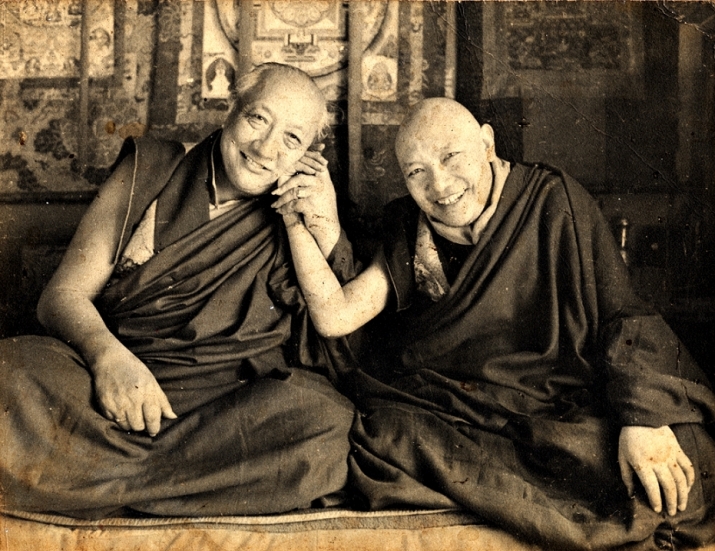 HH Dilgo Khyentse and Trulshik Rinpoche at Shechen Monastery, 1970s. Photo by Marilyn Silverstone
HH Dilgo Khyentse and Trulshik Rinpoche at Shechen Monastery, 1970s. Photo by Marilyn SilverstoneNot only did Trulshik Rinpoche study these important teachings, he put them into practice by completing several three-year retreats, altogether spending about 60 years of his life in closed retreat. After Dzatrul Rinpoche’s parinirvana, Trulshik Rinpoche became abbot of Dzarong Dongak Chöling monastery, where he upheld and propagated the Buddhist teachings.
Following the Chinese invasion in 1959, Rinpoche traveled with his followers to a safe haven in the valleys south of the Mount Everest area, among the Sherpa people of northeastern Nepal. Thubten Chöling, the monastery he founded there, is renowned today as one of the most important centers for the monastic tradition of the Nyingma school of Tibetan Buddhism.
In 1962 in Kalimpong, India, Trulshik Rinpoche sponsored and received from Kyabje Dudjom Rinpoche the empowerments, transmissions, and explanations of the entire Nyingma Kama—the Canonical Scriptures of the Ancient Tradition—and became one of the most important expounders of this unique Dudjom lineage. At that time he met Kyabje Dilgo Khyentse Rinpoche for the first time and received his profound treasure cycle of Nyakluk Phurba. From then on, Trulshik Rinpoche regarded Khyentse Rinpoche as his principal teacher, and in addition to receiving teachings from him, he offered Khyentse Rinpoche some of the rare teachings of which he himself was the holder. This mutual relationship of teacher and disciple was extraordinary, and teachings passed between them like the contents of one vessel poured into another. Kyabje Trulshik Rinpoche eventually became the principal heart son holding the entire lineage of Dilgo Khyentse Rinpoche, and therefore was responsible for searching for, confirming, and enthroning Dilgo Khyentse Rinpoche’s reincarnation. After fulfilling that duty, Kyabje Trulshik Rinpoche also took over Dilgo Khyentse Rinpoche’s responsibility of giving transmissions and empowerments to the 14th Dalai Lama.
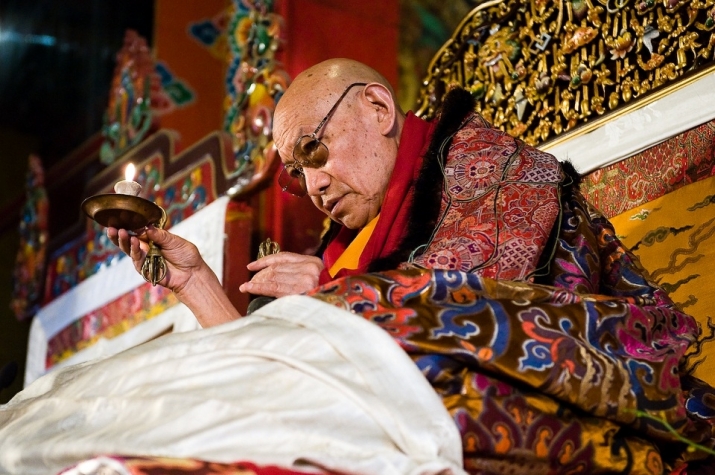 Trulshik Rinpoche during Tulku Urgyen Yangsi Rinpoche's enthronment, November 2008. Photo by Raphaelle Demandre
Trulshik Rinpoche during Tulku Urgyen Yangsi Rinpoche's enthronment, November 2008. Photo by Raphaelle DemandreTrulshik Rinpoche was also the teacher of many other great masters, including His Holiness Sakya Trizin, and transmitted the Treasury of Rediscovered Teachings to the Gyalwang Drukchen at Thubten Chöling. He bestowed several major cycles of teachings to Dilgo Khyentse Yangsi and Dudjom Yangsi Rinpoches and other lineage-holders of all the schools of Tibetan Buddhism at Shechen Monastery in Nepal, including the Treasury of Oral Instructions, the Canonical Scriptures of the Ancient Tradition, and the Four Branches of Heart-Essence.
In his later years Trulshik Rinpoche traveled all over the world, and many lamas of all traditions regarded him as a unique reference point, revered for his vast learning, his integrity, his disarming simplicity, and his unequaled realization and profound spiritual experience. He visited several countries in Asia, including Japan, Thailand, and Malaysia, and also traveled to the West, visiting the United States and many countries in Europe. Rinpoche visited France on numerous occasions, giving many empowerments from the discovered treasures of Kangyur Rinpoche, Dilgo Khyentse Rinpoche, and Dudjom Rinpoche, and instructing three-year retreatants and other disciples in the Dordogne.
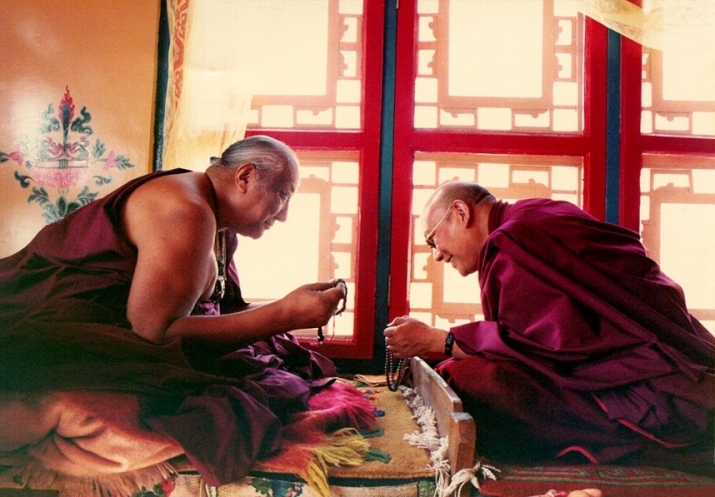 HH Dilgo Khyentse and Truslhik Rinpoche at Shechen Monastery, 1980s. Photo by Matthieu Ricard
HH Dilgo Khyentse and Truslhik Rinpoche at Shechen Monastery, 1980s. Photo by Matthieu RicardKyabje Trulshik Rinpoche continued to work for the benefit of the Dharma and beings well into his eighties, and despite his gradually failing health during his final years, he continued to instruct disciples both in Asia and in Europe, and spent time at Thubten Chöling monastery with his large community of monks, nuns, and retreatants.
His direction of the annual Mani Rimdu festival of masked dance-drama is documented in Richard Kohn's film Lord of the Dance, Destroyer of Illusion (1986), the title of which is partly derived from his name, Trulshik Rinpoche, Precious Destroyer of Illusion. In 2010 he became the fifth head of the Nyingma school, succeeding Kyabje Minling Trichen Rinpoche, who had passed away in 2008.
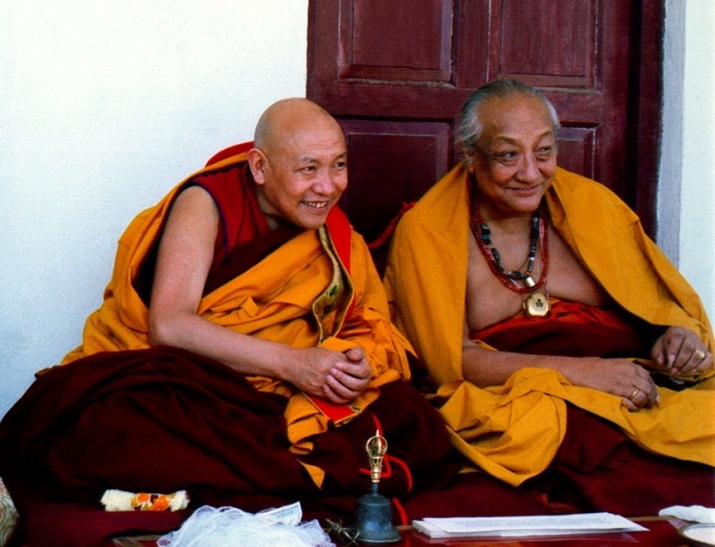 HH Dilgo Khyentse and Trulshik Rinpoche at Shechen Monastery, 1980s. Photo by Matthieu Ricard
HH Dilgo Khyentse and Trulshik Rinpoche at Shechen Monastery, 1980s. Photo by Matthieu RicardRinpoche also undertook the construction of a new monastery above Sitapaila in Kathmandu. He supervised the building and conducted all the ceremonies, including the consecration of the ground, the placing of consecrated vases, images, and mantras within the pillars and beams of the temple, and so on. His new monastery was constructed to remove obstacles in the world in general and especially for the people throughout the Himalayan region. The monastery has a view of the three most important stupas in the Kathmandu Valley: Swayambhunath, Namo Buddha, and Boudhanath. Its location overlooks the valley associated with the Buddha Vairochana; the nearby Swayambhunath hill is associated with the Buddha Vajrasattva; the Tergar monastery hill is associated with the Buddha Ratnasambhava; the hill behind Sitapaila monastery is associated with the Buddha Amitabha; and the forested Nagarjuna hill to the north is associated with the Buddha Amoghasiddhi, so the monastery is in the center of the five Buddha mandala.
Kyabje Trulshik Rinpoche passed away peacefully at the age of 87 on 2 September 2011, in his residence just above Sitapaila monastery. His reincarnation, Ngawang Tendzin Lodrö Rabsel, was born in Kathmandu on 25 July 2013 and recognized by HH the Dalai Lama on 9 July 2015. He now resides at his Sitapaila monastery, where he will soon start his training and studies.
This article was compiled by Ani Jinba Palmo based on oral stories and a written biography composed by Trulshik Rinpoche’s nephew and chief attendant, Kusho Ngawang Tsephel.
Born and educated in Holland, Ani Jinba Palmo is a nun in the Tibetan Buddhist tradition. She ordained in India in 1969. Following the parinirvana of HH Dilgo Khyentse, who was Ani Jinba’s root teacher, a group of Trulshik Rinpoche’s students from Switzerland asked her to translate for them so that they could receive teachings from Trulshik Rinpoche twice a year. She did so in various places, such as Thubten Chöling, Maratika Cave, Boudhanath, Dharamsala, Switzerland, and Sitapaila, between 1992 and 2005. She has also translated a number of books, including The Great Image: The Life Story of Vairochana the Translator (Shambhala, 2004) and Brilliant Moon: The Autobiography of Dilgo Khyentse (Shambhala, 2010).















